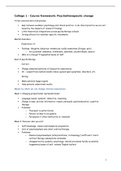College 1 – Course framework: Psychotherapeutic change
A few concerns and a few praises
Gap: between academic psychology and clinical practice: in de clinical practice we are not
bound by the answers of research findings
Little theoretical integrations across psychotherapy schools
Strong effects for disorder-specific treatments
Mental disorders
Experience of:
Feelings, thoughts, behaviour tendencies, bodily sensations (fatigue, pain)
o As a problem: unwanted, intolerable, abnormal, uncontrollable, absurd
Who is in charge? Fragmented sense of ‘self’
Goal of psychotherapy
Correct:
Change unwanted patterns of subjective experiences
Or – viewed from medical model reduce agreed upon symptoms, disorders, etc.
Wrong:
Make patients happy (again)
Help patients understand reality
Means by which we can change internal experiences
Mean 1: Changing propositional representations?
Language-based, symbolic, deductive, reasoning
Change is easy: provide information; reason, persuade: psychoeducation, cognitive
therapy
Problems:
o Therapist is authoritarian
o Patient is likely to be passive
o Persuasion if often ineffective or transient
Mean 2: Discover who you are?
Self knowledge; classical philosophical proposition
Core of psychoanalysis and client-centred therapy
Problems:
o Classical psychoanalysis (interpretations, ‘archaeology’) inefficient; client-
centred therapy assumptions untenable
o Unsupported by academic psychology: mental processes hardly accessible,
fragmented sense of self, instead ‘English butlers’
1
,Brain sub-programmes (English butlers)
Subprocesses which happen automatically
Adaptations of English butlers
Synaptogenesis: making connections between neurons
Improved by motions
Experience-based
Repeated encounters: ‘cells that fire wire together’
Associative representations (e.g., urge to drink alcohol when seeing beer)
Mean 2: Discover who you are? (continued)
Possibility 1: change schematic representations by simultaneously activating multiple
neural networks
o E.g., induce emotions, connect past present future, image, and previous
experience
Experiential techniques: chair technique, imagery rescripting
Problem: typically within sessions
Possibility 2: changing narrative (propositional representations) may be helpful
Mean 3: Systematic exercise?
Change associative representations
Core business in cognitive therapy, behaviour therapy, systems therapy
In and between (homework assignments) sessions
o E.g., exposure, systematically challenging negative automatic thoughts,
behavioural rehearsal, assertiveness training, role playing, communication skills
o Repetition of new learning in order to learn the new associations
A lot of evidence for effectiveness
Problem: patients have to participate otherwise no effectiveness
Mean 4: Patient activation and involvement?
Without involvement no change in the way we experience things
Preferably in and between sessions
o E.g., disclosure (patient), emotional experiences (optimal), training, etc.
Mean 5: High quality therapeutic alliance?
Core ingredient in client-centred therapy and psychoanalysis
Used for motivation and involvement in behaviour therapy and cognitive therapy
Consistently (but moderately strong) related to results
Problem: fuzzy and untested theories in clinical psychology. No proof that the patient
will change due to a relationship
2
, But: sound theories from social psychology and communication science about (resistance
to) social influence
Mean 6: Reorganizing environment & social interactions?
E.g., spouse and family support; enhance/increase social or daily activities; reduce stress
(e.g., moving); job-related interventions
Also (family) care plan (multiple professionals), alert plan, relapse prevention plan
Strong (and last resort) treatment packages for severe psychiatric disorders
Conclusions
Psychotherapy: undertaking aimed at changing unwanted patterns of experience: ‘That things are
otherwise’ had to be made available
Means
Patients’ involvement
High quality therapeutic relationship
Providing information (propositional)
Systematic exercise (associative)
Simultaneous activation of meanings (schema)
For severe psychiatric disorders:
Rearranging environment
College 2– Behaviour Therapy
Characteristics
Behaviour therapy: correct characteristics
Psychopathology (psychological problems) based on S-R associations: an interaction
between person and environment
o Behaviour therapists are interested in the situation and the behaviour in that
situation
Rather symptom- than person-oriented
Observation and self-monitoring are part of treatment and treatment
planning/evaluations
Behaviour therapy: incorrect characteristics
BT involves behaviour only
BT is cold and mechanical
BT is fully evidence-based
BT process
1. Problem inventory
What is the problem? How often? How severe?
How did it start? Course? Why treatment now?
What elicits or exacerbates the problem?
What prevents or reduces the problem?
Positive consequences? Short-term? Long-term?
3
, Negative consequences? Short-term? Long-Term
What means or solutions have already tried?
What is the treatment goal?
2. Holistic theory - example
Therapist makes a sort of check/schema of the information
he/she has and check whether this is right or wrong
3. Problem selection, measurement, and functional analysis
Functional analysis: way of understanding what sort of conditioning processes are here at
hand
Classical and operant conditioning
Classical conditioning
Unconditioned stimulus (UCS = food) elicits unconditioned response (UCR = saliva)
After repeated trials
Conditioned stimulus (CS = bell) elicits conditioned response (CR = saliva) Dog attached
‘meaning’ to the CS
Classical conditioning – Patient’s description
Trichotillomania (urge to pull out hair)
CS ‘…in the evening when I am tired…’
‘…TV on…’, ‘…while studying…’, ‘…when I feel down…’ ‘…while talking on the phone…’
CR ‘…I feel the urge to…’, ‘…select one hair and start pulling…’
Dog phobia
CS ‘…especially in parks…’, ‘…when the dog is not leashed…’, ‘…small dogs also…’
CR ‘…then I panic…’, ‘…haven’t visited my aunt since then…’
Operant conditioning
Sd: R-S
Given a discriminative stimulus (Sd), certain behaviour (R), results in a situation (S) becoming
(more) positive or negative
S+ or S- = pleasant or unpleasant
4




